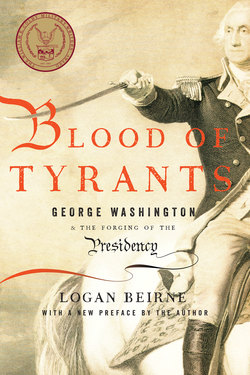Читать книгу Blood of Tyrants - Logan Beirne - Страница 8
На сайте Литреса книга снята с продажи.
ОглавлениеThis unfinished—and unflattering—portrait by Gilbert Stuart ironically came to be the most famous depiction of Washington. Martha Washington criticized it as not a “true resemblance.” Photograph © 2013 Museum of Fine Arts, Boston; National Portrait Gallery, Smithsonian Institution / Art Resource, NY
Martha and George Washington entertained a great many visitors at their grand Mount Vernon estate beside the Potomac. In fact, the visitors became so frequent that George resorted to removing signage in order to confuse would-be houseguests. Library of Congress, Prints & Photographs Division, LC-DIG-pga-01228
This print depicts Independence Hall at the time of the signing of the Declaration of Independence in 1776. This building served as the principle seat of government, except for periods when Congress was forced by the advancing British forces to evacuate. With the postwar government failing, Washington and other patriot leaders returned in 1787 for the Constitutional Convention. Library of Congress, Prints & Photographs Division, LC-DIG-pga-04142
With the help of his assistants, Washington produced an amazing 140,000 documents during the Revolutionary War. Foreseeing his letters’ value to posterity, he checked virtually all of the scribes’ work and held each letter to exacting standards. He spent his nights documenting his actions and explaining to Congress what was needed to conduct the war. This image of his inaugural address depicts Washington’s own fine penmanship. National Archives (Records of the U.S. Senate)
Washington was born into a family of relatively modest means but worked (and married) his way into wealth. This depiction of Washington as a child is titled “Father, I cannot tell a lie: I cut the tree,” and perpetuates the cherry tree myth. Washington indeed told a great many lies, and his knack for deception enabled the United States to outwit the British and win the war. Library of Congress, Prints & Photographs Division, LC-DIG-pga-02152
The Sons of Liberty punish a Loyalist for his opposition to the Revolution. The practice of “tarring and feathering” had originated in 1189 with Richard the Lionheart during the Crusades, but was not used extensively until the colonists revived it during their revolt against Britain. National Archives photo no. 148-GW-436 (The George Washington Bicentennial Commission)
Throwing caution to the wind, Ethan Allen launches a daring surprise attack on Fort Ticonderoga in May 1775. The sleeping British did not even have time to dress, let alone put up a fight. National Archives photo no. 111-SC-94758 (Signal Corps Photographs of American Military Activity)
This portrait depicts Benjamin Franklin, John Adams, and Thomas Jefferson poring over a draft of the Declaration of Independence at Jefferson’s lodgings in Philadelphia in June 1776. In an early draft, Jefferson referred to the American people as “subjects.” While he simply crossed out other errors in the draft, this was the only word that he obliterated with furious strokes of his pen. The American people were no longer “subjects” of any king. Library of Congress, Prints & Photographs Division, LC-USZC4-9904
George Washington organizes a masterful secret retreat from Long Island during a violent storm in August 1776. According to one soldier’s diary, the troops, “strictly enjoined not to speak, or even cough,” silently filed into the boats, and New England fishermen used their unique skill set to ferry them to safety in Manhattan. National Archives photo no. 148-GW-174 (The George Washington Bicentennial Commission)
During that winter of 1777–1778 at Valley Forge, Washington pleaded with Congress for food, clothing, and supplies, writing, “I am now convinced, beyond a Doubt that unless some great and capital change suddenly takes place in that line, this Army must inevitably be reduced to one or other of these three things. Starve, dissolve, or disperse, in order to obtain subsistence.” National Archives photo no. 148-GW-436 (The George Washington Bicentennial Commission)
Sloppy in appearance and crude in manner, Charles Lee was reputed to have a romantic life “of the transient kind.” A military genius who resented serving under Washington, he got along better with his pack of dogs than he did with most people. Library of Congress, Prints & Photographs Division, LC-USZ62-3617
“Parade with us, my brave fellows!” Washington shouts as he leads the charge at Princeton in January 1777. With his hat in hand, he rode ahead on his horse, yelling, “There is but a handful of the enemy, and we will have them directly.” Despite being caught in the crossfire, Washington emerged unscathed as he had done time and again. He believed that a divine Providence protected him. National Archives photo no. 148-GW-335 (The George Washington Bicentennial Commission)
American women were crucial to winning the Revolutionary War, with some even jumping into battle. When John Adams wrote his wife of the Continental Army’s defeats, Abigail confidently declared that if Washington’s troops were overrun, the British forces would then be compelled to fight “a race of Amazons in America.” National Archives photo no. 148-GW-436 (The George Washington Bicentennial Commission)
Alexander Hamilton served as Washington’s shrewd right-hand man and one of his closest confidants during the war. After the United States’ victory, he ardently advocated a more centralized nation. National Archives photo no. 148-GW-436 (The George Washington Bicentennial Commission)
A mere five feet tall and 120 pounds, James Madison was an intellectual giant and a driving force behind the drafting of the Constitution. He declared that creating even a “limited monarchy . . . was out of the question” and used his masterful political skills to help form the new republican government. Library of Congress, Prints & Photographs Division, LC-DIG-ppmsca-19166
The wily Benjamin Franklin used his guile to charm the French court—particularly the female contingent. Through parties and chess games, he persuaded the French to send aid to the American cause and eventually declare war on Britain. As the war wound down, he then infuriated the French by working with John Adams and John Jay to outmaneuver them in the peace process. Library of Congress, Prints & Photographs Division, LC-DIG-pga-01591
